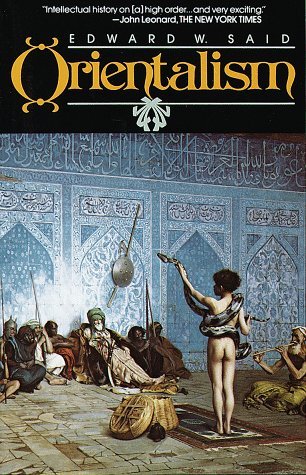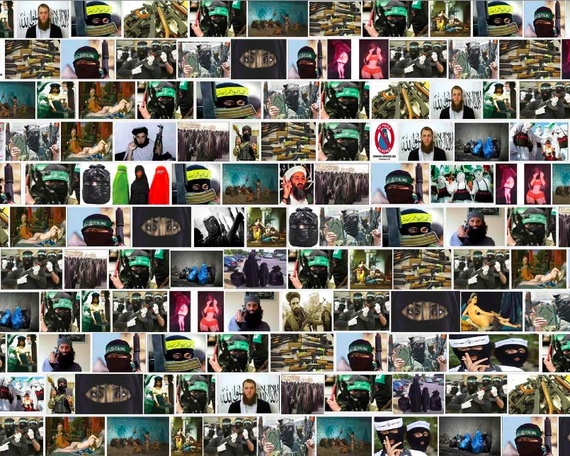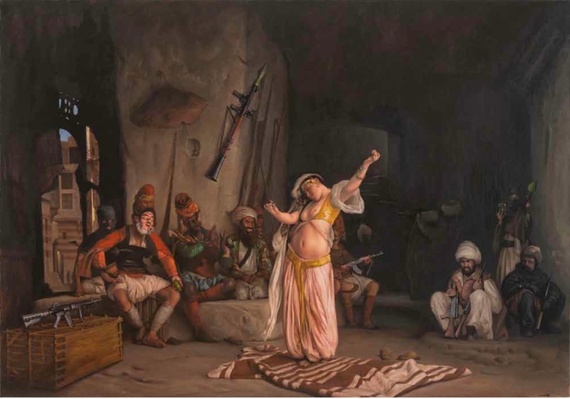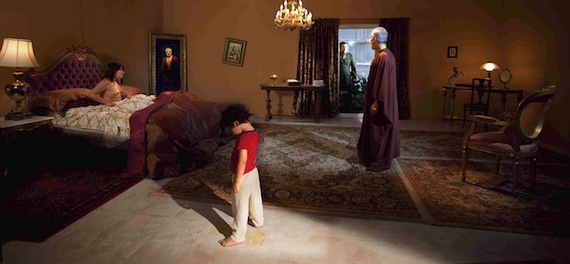Artist Shoja Azari might be well familiar with the abuse and manipulation of icons, having come to New York, post-Islamic Revolution from Iran in 1983 where he had been a writer involved in theater and politics. Since 1997 he has collaborated with his partner Shirin Neshat on many projects, but while Iran remains a bridge between them, their inspirations diverge: the exiled eye formulates many connections to the homeland -- some look back with a cynical eye, while others with nostalgia.
In FAKE: Idyllic Life, at the Leila Heller Gallery, Azari takes Orientalism and romantic projections from the past and redefines them for the era of the Internet when political boundaries are increasingly blurred by digital democracy.
When the Palestinian writer Edward Said explored the skewed Western perspective of the Near East and wrote his now-famous book Orientalism in 1978, Palestinians were striving for nationhood then, and still are now -- but with time marching into the digital age, safeguarding a distinct national identity seems increasingly anachronistic, even futile.
Azari takes Said's original book cover, which depicts Jean-Léone Gérôme's The Snake Charmer (1879), and sneaks in a woman among the seated assembly while updating the ancient implements of war with Kalashnikovs. In Oriental Bath or The Centerfold, the artist replaces the odalisques of yore with the sexy coquetry of Playboy bunnies, and the gallery is wallpapered with pictures plundered from news cycles of Islamic imagery, brutalized sexuality and violence.
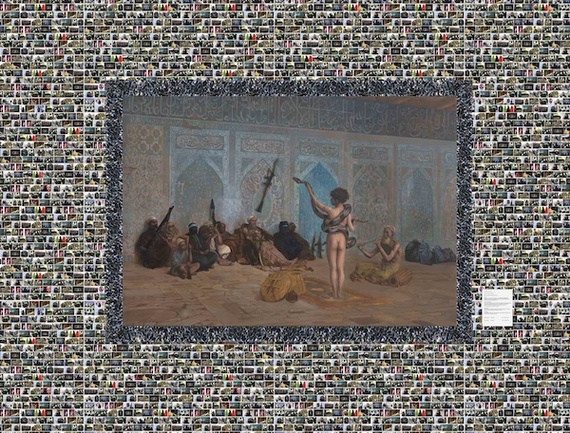
The Snake Charmer or The Anatomy of the 21st century Savage, 2013 Oil on canvas 40 x 58 in / 101.6 x 147.3 cm
In the post-colonialist era, the cultural critic Édouard Glissant has written about this creolization or "deterritorialization" resulting in hybrid cultures. The idea that cultural memes converge in the virtual space, was recently tracked by the artist Taryn Simon, whose web program ImageAtlas.org lets a user enter a word that Google translates into a variety of languages, that then trawls the originating country's web for the five top images illustrating that word. For example, typing in the word "love," I came up with plump red hallmark hearts which were as ubiquitous in Syria as they were in Brazil, with some notable exceptions being India, (which offered up Hindu devotional iconography), and North Korea - where that concept must still be gaining ground.
Azari's work is more concerned with the anxieties this generates, and the crisis of identity. Speaking as an emigrant himself he explained, "Since 9/11 we have been bombarded with images and news of an impending terror -- and as a consequence the war on terror has exacerbated this deep sense of apprehension that we always felt as foreigners." Anxiety also stems from a society addicted to bits of news and information, which, he later told me, "leaves one with a sense of a fragmented world without the possibility of a cohesive understanding." For the wallpapers, Azari said he Googled phrases such as, "Muslim Rage," "Muslim fanatics," "Crazy terrorists," to get a sense of what we were processing each day. He then incorporated these images with painted replicas of the 18th and 19th century Orientalist paintings.
I asked Azari whose perspective he intended to define through the altered paintings, and he said, "By presenting it in the larger context of the wallpaper images, we visually see the continuation of the Western gaze into the other as it relates to the dominant narrative of the last few hundred years. Perhaps this is how I have been trying to deal with this sense of apprehension and helplessness - by putting things in historical context."
When Sir Richard Burton, the first Western visitor to Mecca, brought notions of an exotic orient into prudish Victorian living rooms by regaling readers with titillating translations of the Kama Sutra and The Perfumed Garden, they were heavily embellished with cultural biases, inflected with colonial arrogances and the taboos of his era. If Orientalism once represented a romantic Western view of the orient, that once-dominant framing view has perhaps been co-opted by digital cameras on both sides of the hemisphere.
In his video, The King of Black, Azari explores cultural reflections on paradise, ideas of heaven and hell as conceits that mirror gender biases of their eras. In this Islamic vision of Eden, "If you are a woman, you are probably destined to become an houri in the service of males," remarked Azari to me in jest.
Marco Polo's journal cites the tribe of the Assassins on his visit to Alamut in 1273, recounting the allure of paradise in a tale passed down to him, that in many forms, still seduces boys recruited for assassinations today:
"The Old Man kept at his court such boys of twelve years old as seemed to him destined to become courageous men. When the Old Man sent them into the garden in groups of four, ten or twenty, he gave them hashish to drink. They slept for three days, then they were carried sleeping into the garden where he had them awakened."
"When these young men woke, and found themselves in the garden with all these marvelous things, they truly believed themselves to be in paradise. And these damsels were always with them in songs and great entertainments; they; received everything they asked for, so that they would never have left that garden of their own will."
"And when the Old Man wished to kill someone, he would take him and say: 'Go and do this thing. I do this because I want to make you return to paradise'. And the assassins go and perform the deed willingly."-Marco Polo 1273
Originally a poet, Azari's words and musings are evoked in many of his works with Shirin Neshat, from their first video collaboration, Turbulent (1997) to their 2012 staging for Performa 11 of "Overruled." With Neshat he also co-wrote the feature length Women Without Men and their next film in progress he says, remains of central focus. For some time also, Azari has moved toward experimenting on digital overlays and video projections over painted canvases with Shahram Karimi, and in Idyllic Life, he updates the narrative from a 12th century miniature illustration through a video installation. Many more of his video overlays are on display at his concurrent exhibition at Mana Contemporary, in their new expansive spaces, which are well worth the trek.
From an earlier photographic series of Shoja Azari's, where he explores childhood and memories - Interrupted Series, 2010 C-Print Edition of 5 40 x 60 in

Shoja Azari, Oriental Bath or The Centerfold (2013),
detail Oil on canvas 35 x 22 in / 88.9 x 55.9 cm
For further information:
Leila Heller Gallery, New York
Shoja Azari at ManaFest
Text & Interviews: www.KisaLala.com
instagram.com/kisa_lala

